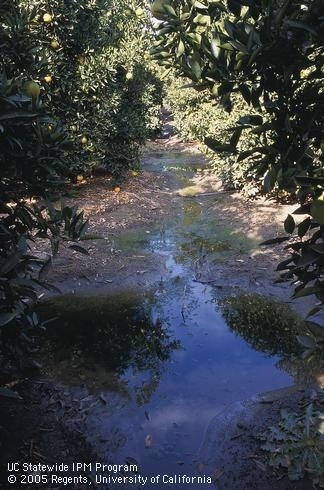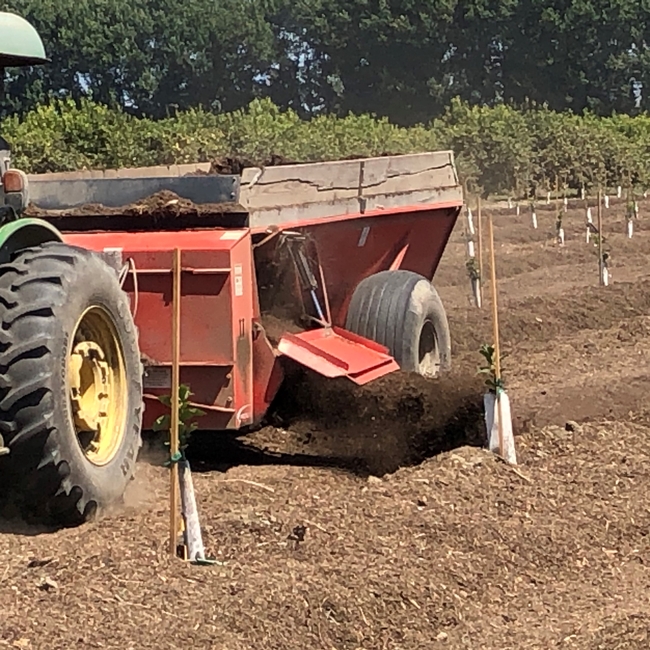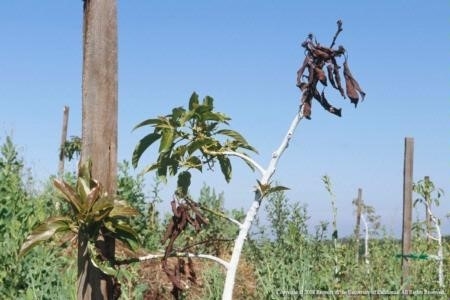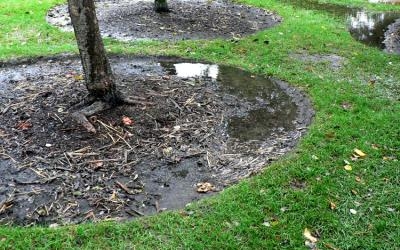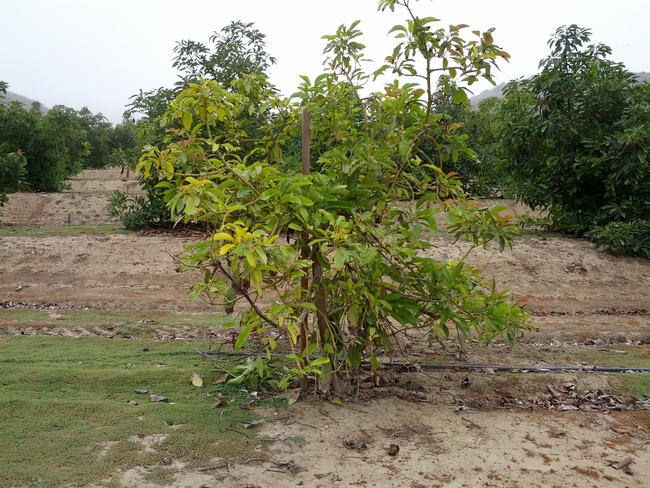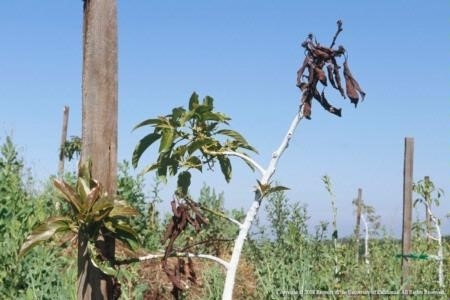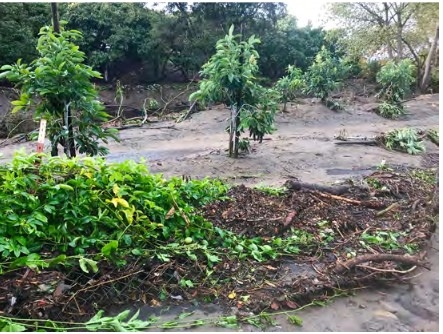
Posts Tagged: rain
Too Much Rain? A Blog Refrain
A repeat post from the recent past
- Author: Ben Faber
What Can Happen With Too Much Rain? Watch that Mulch!!!
Rain is wonderful stuff. If it comes and washes the accumulated salts of the last several years out of the root zones of citrus and avocado, that's a good thing. But what happens if there is a little too much of the good stuff? In the winter of 2005, Venture got over 40” of rain, which is 200% of what is normal. The last time big rains occurred prior to that was in the winter of 1997-98. That year the rains were evenly spaced on almost a weekly basis through the winter and into the late spring and over 50" fell. That year we had major problems with both citrus and avocados collapsing from asphyxiation. The same occurred in 2005, but not so pronounced.
Rain is good, right?
In 2003 we had a lot more rain than we normally see and in Carpinteria it rained 4 inches in July!!!!!! In some young trees with poorly developed root systems, we have seen some collapse from asphyxiation. Avocados tend to be more susceptible than citrus, and some rootstocks more than others. Even big trees collapsed.
Asphyxiation is a physiological problem that may affect certain branches, whole limbs or the entire tree. Leaves wilt and may fall, the fruit withers and drops and the branches die back to a greater or lesser extent. The condition develops so rapidly that it may be regarded as a form of collapse. Usually, the larger stems and branches remain alive, and after a time, vigorous new growth is put out so that the tree tends to recover. Young trees can be harder hit, but sunburn damage from lack of leaves may be more of a problem.
Asphyxiation is related to the air and water conditions of the soil. The trouble appears mainly in fine-textured or shallow soils with impervious sub-soils. In 1997-98, this even occurred on slopes with normally good drainage because the rains were so frequent. When such soils are over-irrigated or wetted by rains, the water displaces the soil oxygen. The smaller roots die when deprived of oxygen. When the stress of water shortage develops, the impaired roots are unable to supply water to the leaves rapidly enough and the tree collapses. The condition is accentuated when rainy weather is followed by winds or warm conditions.
It doesn't take standing water to have asphyxiation occur.

water puddling
Mulch and TOO Much Rain
What Can Happen With Too Much Rain? Watch that Mulch!!!
Rain is wonderful stuff. If it comes and washes the accumulated salts of the last several years out of the root zones of citrus and avocado, that's a good thing. But what happens if there is a little too much of the good stuff? In the winter of 2005, Venture got over 40” of rain, which is 200% of what is normal. The last time big rains occurred prior to that was in the winter of 1997-98. That year the rains were evenly spaced on almost a weekly basis through the winter and into the late spring and over 50" fell. That year we had major problems with both citrus and avocados collapsing from asphyxiation. The same occurred in 2005, but not so pronounced.
Rain is good, right?
In 2003 we had a lot more rain than we normally see and in Carpinteria it rained 4 inches in July!!!!!! In some young trees with poorly developed root systems, we have seen some collapse from asphyxiation. Avocados tend to be more susceptible than citrus, and some rootstocks more than others. Even big trees collapsed.
Asphyxiation is a physiological problem that may affect certain branches, whole limbs or the entire tree. Leaves wilt and may fall, the fruit withers and drops and the branches die back to a greater or lesser extent. The condition develops so rapidly that it may be regarded as a form of collapse. Usually, the larger stems and branches remain alive, and after a time, vigorous new growth is put out so that the tree tends to recover. Young trees can be harder hit, but sunburn damage from lack of leaves may be more of a problem.
Asphyxiation is related to the air and water conditions of the soil. The trouble appears mainly in fine-textured or shallow soils with impervious sub-soils. In 1997-98, this even occurred on slopes with normally good drainage because the rains were so frequent. When such soils are over-irrigated or wetted by rains, the water displaces the soil oxygen. The smaller roots die when deprived of oxygen. When the stress of water shortage develops, the impaired roots are unable to supply water to the leaves rapidly enough and the tree collapses. The condition is accentuated when rainy weather is followed by winds or warm conditions.
It doesn't take standing water to have asphyxiation occur.
Mulch is good, right?
It can get spread awfully thick
Mulch does lots of good things, like reducing erosion, controlling weeds, improving infiltration, increasing organic matter to control root disease, reducing soil temperatures, reducing evaporation loss and therefore improving soil moisture content. Ah, but that is a problem when there is a lot of rain. It can lead to asphyxiation, just because of that last point. In rainy conditions, there needs to be a period of air entry into the soil and mulch because it reduces evaporative loss can keep the soil TOO wet, leading to asphyxiation.
Asphyxiated tree that has been overmulched and is now recovering after whitewashing.
So what do you do? With a thick layer of mulch when there is too much rain? You pull it away several feet from the base of the tree, so that sun can dry out the soil. It's a lot of work, especially after you have put a lot of work into spreading it.
The roots need to dry out and it can only happen if exposed to light and wind and ambient temperature
On flat ground, your avocados are planted on mounds or berms. And the soil texture is somewhat sandy and well drained. In that case, unless we get rain like 1997-98 when Ojai got nearly 50 inches and it rained just about every week from November through April and it seemed everything was under water, most trees should be all right. But, this last rainfall year I saw cases where unbermed, heavy soil avocado plantings had severe asphyxiation problems. So be forewarned.
Wet Roots
I recently harvested 'GEM' avocados and found that some of the fruit was splitting. The split fruit was just turning from a bright green to one with dark tinges. There were also gobs of snails and slugs on the fruit. I mentioned the cracking fruit to a grower who had been harvesting ‘Hass' fruit and the comment was that their fruit was turning black on the tree and falling. This is way early for ‘Hass' to show this level of maturity.
Several mandarin growers also mention peel breakdown or rind disorder. There can be brown, water-soaked blotches or dark, sunken areas developing on the rind after rainy weather. The fruit matures rapidly, turning orange early. Secondary fungi can then colonize the affected areas. It's more of a problem in northern California where thin-skinned satsumas are grown and there are early rains. But accelerated maturity and fruit/whole plant breakdown can happen on all citrus and many other fruiting plant species.
This is another example of accelerated maturity due to wet roots. The roots need air, like we do, and when they are asphyxiated for even short periods of time, they start signaling the rest of the plant that something is wrong. Prolonged rainy periods or actual ponding conditions will lead to ethylene precursors that start the maturation process – “banana in a bag” effect. This is in spite of many crops being delayed in their maturity because of the cold winter we have had. Drown the roots, and they start responding as if they are choking. They are. In some cases, leaves will droop (epinasty or wilting) and drop, immediately. And then the fruit may drop right away or then just start rapidly maturing/ripening on the tree. Once this process starts, there's no stopping it. Some growers, seeing fruit drop have gone out to start harvests, but then inadvertently gotten their forklifts stuck in the mud. Rain can have its downsides.

mandarin rind disorder

lemon cold wet exposure
Rain and Mud in the Orchard
What Can Happen With Too Much Rain? And Mud?
Rain is wonderful stuff. If it comes and washes the accumulated salts of the last several years out of the root zones of citrus and avocado, that's a good thing. But what happens if there is a little too much of the good stuff? In the winter of 2005, Venture got over 40” of rain, which is 200% of what is normal. The last time big rains occurred prior to that was in the winter of 1997-98. That year the rains were evenly spaced on almost a weekly basis through the winter and into the late spring and over 50" fell. That year we had major problems with both citrus and avocados collapsing from asphyxiation. The same occurred in 2005, but not so pronounced.
This winter we have had a lot more rain than we normally see and in some young trees with poorly developed root systems, we have seen some collapse.from asphyxiation. Avocados tend to be more susceptible than citrus, and some rootstocks more than others. We have also had some trees buried in mud slides, which can also lead to asphyxiation.
Asphyxiation is a physiological problem that may affect certain branches, whole limbs or the entire tree. Leaves wilt and may fall, the fruit withers and drops and the branches die back to a greater or lesser extent. The condition develops so rapidly that it may be regarded as a form of collapse. Usually, the larger stems and branches remain alive, and after a time, vigorous new growth is put out so that the tree tends to recover. Young trees can be harder hit, but sunburn damage from lack of leaves may be more of a problem.
Asphyxiation is related to the air and water conditions of the soil. The trouble appears mainly in fine-textured or shallow soils with impervious sub-soils. In 1997-98, this even occurred on slopes with normally good drainage because the rains were so frequent. When such soils are over-irrigated or wetted by rains, the water displaces the soil oxygen. The smaller roots die when deprived of oxygen. When the stress of water shortage develops, the impaired roots are unable to supply water to the leaves rapidly enough and the tree collapses. The condition is accentuated when rainy weather is followed by winds or warm conditions. These are exactly the conditions we have seen in the last two weeks, hence some of the problems in young orchards on heavier soils.
It doesn't take standing water to have asphyxiation occur.
Canopy treatment in less severe instances of asphyxiation consists of cutting back the dead branches to live wood. If leaf drop has been excessive, the tree should be whitewashed to prevent sunburn. Fruit, if mature should be harvested as soon as possible to prevent loss. In the case of young trees, less than two years of age, recovery sometimes does not occur, and replanting should be considered if vigorous regrowth does not occur by July. As soon as defoliation is evident, whitewashing should be done to protect them to give them a chance for recovery.
Asphyxiation can be reduced by proper planting and grading. If an impervious layer is identified, it should be ripped prior to planting. The field should be graded so that water has somewhere to run off the field during high rainfall years. Heavier soils might require planting on berms or mounds so that the crown roots have a better chance of being aerated.
Hindsight is always great. Post-plant, if an impervious layer can be identified and is shallow enough to break through, ripping alongside the tree or drilling 4-6 inch post holes at the corners of the tree canopy can improve drainage. It is important that the ripper blade or auger gets below the impervious layer for this technique to be effective. If there is a thick layer of mulch reducing soil evaporation, pulling it back to allow the sun to help dry it out faster will help. It's not a lot of work with small trees, but big time work if it's big trees with thick mulch.
Asphyxiated tree that has been whitewashed
In the case of trees being buried, especially covering the bud union, they should be dug out as soon as practical.They need to be dug out down to the original ground level about 3 feet out from trunk. Then over time, excavated out about 6-8 feet from trunk. It doesn't have to be done today, but soon, before the weather heats up and transpiration demand increases. So in the next month at latest. Start slow and gradually the mud can be moved out further from the tree.
Trees buried above bud union that need to have soil removed down to original soil level.
Satsuma Rind Breakdown
Although you never know about the weather, we do know that if heavy rain occurs after color break in mandarins there can be significant rind breakdown. This problem can destroy much of the crop and the problem is largely preventable.
Pre-harvest rind decay of mandarins in California generally occurs shortly after rain falls and is most severe on Satsuma mandarins. Although some researchers have associated the problem with fungi such as Alternaria species, isolations from affected fret have been inconsistent. Inoculations with isolated fungi only sometimes reproduce disease symptoms and only on water-soaked fruit. Furthermore, in preliminary field trials there were conducted in Butte Co in the fall of 2002 and 2003, fungicide treatments that included Topsin-M, Pristine and Abound only reduced the incidence of disease from 99% in the control to approximately 90% . These data suggested that mandarin rind breakdown is a physiological, abiotic disorder of fruit rather than a pathological problem and the fungi isolated are rather secondary causes of rind decay than primary pathogens.
Rind breakdown of citrus was previously reported by Fawcett and others in the 1930s. Wet weather combined with a sudden decrease in temperature was shown to result in generation of rind oil and collapse of cells just under the cuticle. In laboratory and field trials in 2003, fruit treatments with water repellants reduced the incidence of rind breakdown to very low levels. Field trials were again conducted in the fall of 2004. Fungicide treatments were ineffective in these trials. In all trials, application so Vapor-Gard or Omni oil significantly reduced the disorder. In all programs with Vapor-
Vapor-Gard and Omni oil, a first application was made at the end of October and there was no significant difference in efficacy when additions applications were done. When tree were protected from rainfall using a tent, the disorder could not be detected, indicating the rind breakdown is correlated to rainfall.
In summary, results from the trials support previous findings by Fawcett that mandarin rind disorder is an abiotic, weather-related problem of mature fruit that has undergone a green to orange color change. Using a water repellant helps protect the fruit.
https://apsjournals.apsnet.org/doi/pdf/10.1094/PDIS-07-10-0484
Etiology and Management of a Mandarin Rind Disorder in California
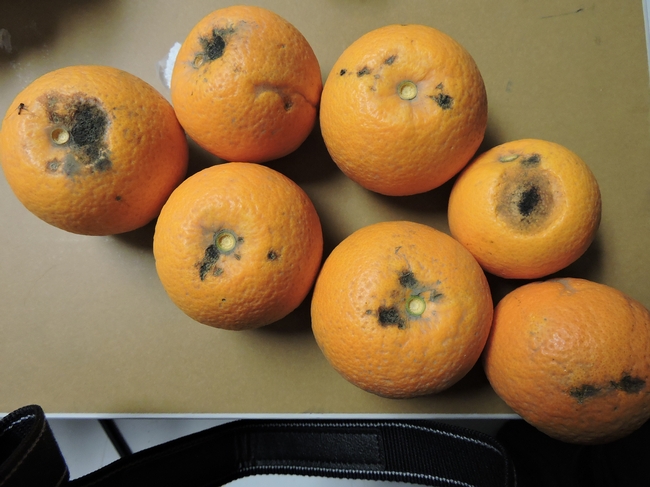
mandarin breakdown peel

